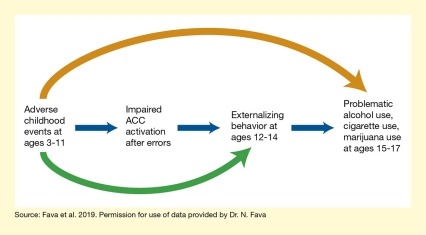This study found that:

- People who experienced more childhood adversity had higher rates of substance use in late adolescence.
- Children who experienced adversity were more likely to show externalizing behavior (e.g., aggression, delinquency) in early adolescence, which in turn predicted substance use in late adolescence.
- Reduced activation of the brain’s anterior cingulate cortex mediates the relationship between childhood adversity and increased externalizing behavior.
People who experience adversity and trauma during childhood are more likely to use alcohol and other drugs during adolescence and to initiate substance use earlier. The neural mechanisms linking childhood adversity and adolescent substance use, however, are poorly understood. Recent studies have implicated areas in the brain’s frontal lobe in this association. One of these regions is the anterior cingulate cortex (ACC), which is involved in impulse control and decision making.
In a NIDA-sponsored study, Dr. Nicole Fava and colleagues from Florida International University and the University of Michigan combined information about parent-reported adverse childhood events, teacher-reported externalizing behavior, and adolescent’s self-reported substance use with brain imaging data to show that childhood adversity is associated with altered ACC activity in certain situations. This altered ACC activity, in turn, is linked with behavior problems in early adolescence and substance use in late adolescence. Dr. Fava explains their multidisciplinary approach, saying, “We don’t know much about how childhood adversity and trauma and adolescent substance use are connected. We were interested in examining that ‘how’ by collaborating with researchers in different fields.”
Relationship Between Childhood Adversity, Brain Function, and Behavior
The study included 465 adolescents who participated in a long-term study of families at high, intermediate, or low risk of substance use. Over the course of the study, the researchers assessed:
- Adverse childhood experiences from ages 3 to 11.
- Externalizing behavior (e.g., aggression, delinquency) at ages 12 to 14.
- Substance use at ages 15 to 17.
The study results confirmed that childhood trauma and adversity, such as physical abuse/punishment, poverty, and parent-on-parent violence, increased the risk of alcohol, tobacco, and marijuana use in adolescence. This relationship was mediated by increased externalizing behavior in early adolescence. Thus, youth with more adverse childhood experiences were more likely to show aggression or delinquency at ages 12 to 14, which in turn predicted greater risk of substance use.
Dr. Fava and colleagues additionally conducted a functional magnetic resonance imaging (fMRI) analysis on 92 of the participants between the ages of 9 and 15. fMRI measures brain activity while a participant completes a task—in this case, a so-called go/no-go task, where participants were instructed to press a button in response to seeing a certain stimulus (e.g., specific letters) but make no response when seeing another infrequent stimulus. The team analyzed the brain activity recorded in the ACC when the participants succeeded or failed at the task. Children who experienced adversity and trauma showed lower activation of the ACC when they failed at completing the study task, and these youth were also more likely to show behavior problems (see Figure). Thus, ACC activity may help explain the link between childhood adversity and externalizing behavior in early adolescence.
The associations accounted for only a portion of the relationships between childhood adversity, externalizing behavior, and adolescent substance use; other factors certainly also play a role. Nonetheless, the observed reduced ACC activation suggests that adverse and traumatic childhood experiences can impair error monitoring in the brain and thus prevent youth from learning from their mistakes. Dr. Fava explains, “If certain youth are not learning from their mistakes, and if we think about mistakes as being synonymous with risky behaviors—or in this case, substance use—then youth will keep using substances in the future until they are able to learn from their mistakes.”
These findings may help improve adolescent substance use prevention and treatment strategies by not basing health interventions on behavioral observations alone but also on indicators of brain activity, such as fMRI. Dr. Fava says, “It may be more effective to consider the impact of trauma when planning interventions—using techniques such as mindfulness, neurofeedback techniques, and trauma-focused cognitive behavioral therapy, to name a few—to help adolescents discontinue substance use.”
This work was supported by NIDA grant DA027261.
- Text Description of Figure
-
The figure illustrates the relationship and mediating factors between adverse childhood events substance use in late adolescence. As indicated by three blue arrows in the middle of the figure, adverse childhood events at age 3 to 11 increase likelihood of impaired activation of the ACC after committing errors on assigned tasks; impaired ACC activation contributes to increased risk of externalizing behavior at ages 12 to 14, and externalizing behavior is associated with problematic alcohol, cigarette, or marijuana use at ages 15 to 17. A brown arrow at the top indicates that adverse childhood experiences may also contribute to substance use in late adolescence through other mechanisms. Similarly, a green arrow at the bottom indicates that adverse childhood experiences may increase risk of externalizing behavior through pathways unrelated to ACC activation.
Source
- Fava, N.M., Trucco, E.M., Martz, M.E., et al. Childhood adversity, externalizing behavior, and substance use in adolescence: Mediating effects of anterior cingulate cortex activation during inhibitory errors. Development and Psychopathology, 2019;31(4):1439–1450.
